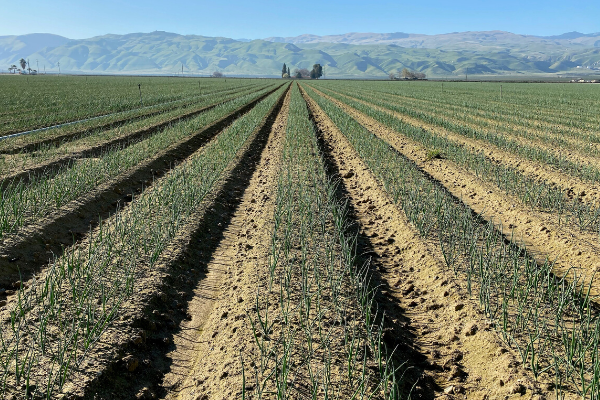Onion and Garlic Market Report- February 2020
US ONION
The US CY20 onion planting is ~90% complete and planted acreage is likely to be similar to the last season. Precipitation has tapered off over the past few weeks; however, overall winter weather conditions have been favorable. No onion crop issues have been reported at this time.
Processors continue to manage the rise in costs associated with transportation, labor, utilities, packaging and irradiation along with the impact of California’s Sustainable Groundwater Management Act (SGMA), which puts into effect a long-term, viable supply of water for the state.


EGYPTIAN ONION
Egypt’s CY 19-20 winter yellow onion crop is 40 - 45% complete. The crop is estimated to come in ~20 % lower than last year. The crop quality has been normal and no weather anomalies have been experienced to date. Fresh Egypt onion prices, which had spiked in Q4, 2019 driven by shortages in India, have seen a gradual reduction in tandem with increased early spring crop arrivals in India.
Egypt’s Summer White onion crop planting has commenced and is progressing well. Estimated acreage is slightly higher than last season and the crop is expected to come in at ~5kMT. Harvest will commence in late April or May.
OTHER ORIGINS
India’s overall 2019 - 2020 spring white onion crop is estimated to be 30 - 40% higher than the previous season. Harvest is delayed by a month and will commence at the end of March. Processed material will only be available for shipment by May or June and a severely depleted carry-in inventory position will limit export availability.
FUTURE OUTLOOK
US
- Current inventories are adequate to service market demand for most fractions and micros through new crop (June 2020)
- Extra-low micro powders, toasted and irradiated SKUs will be tight through new crop arrivals
- If there is no untoward weather event, market pricing for CY 2020 will increase progressively for the 20-21 contract cycle due to cost-push increases mentioned above
Egypt
- Winter crop availability will start thinning out in the next few weeks as the crop winds down
- Dried onion prices are stable at the moment but will start hardening from current levels as competition increases from the fresh local/export markets and availability reduces through April
Other Origins
- Indian dried onion prices are stable with a strong undertone, driven by lack of old crop inventory and a delayed harvest. Prices could weaken after mid-year, if the crop is normal
- Chinese pricing is likely to mimic Indian pricing for most markets but could see shipment disruption and hardened pricing in the near/medium term due to the impact of COVID-19
CHINESE GARLIC
China is currently in the midst of a potentially fatal respiratory virus epidemic (COVID-19), which is having a growing adverse impact on human health and also causing significant disruption to China linked supply chains across the globe.
As the enormity of the epidemic came to light in January, Chinese authorities quarantined the Hubei province and other high infection areas, by holding a mandatory extension of the Chinese Lunar New Year holiday by a week, across the country. This severely restricted movement of people and goods between provinces, while at the same time ramping up daily health checks across plants and offices.
The above measures have resulted in delayed startup of garlic processing operations across China. Many garlic processors are still operating at below optimum capacity due to labor shortages, as well as transportation bottlenecks and tight working capital. Fresh Chinese garlic prices rose 22% since the markets reopened after the Chinese New Year, over levels prevailing at the end of January, before leveling off to some extent. Flake markets remain closed.
Meanwhile, shipping bottlenecks are worsening as more leading shipping lines increase the number of “blank sailings” between the United States/Europe and China. This is likely to lead to sharp increases in freight rates and surcharges as limited container inventory finds the highest bidders.
Olam China restarted operations on February 10, 2020 and has progressively ramped up processing activity over the past 2 weeks. The plant will reach peak operating capacity by the end of February. Shipments started off slow after February 10 and are currently slightly behind plan for the month. They should be caught up my March 2020.
All the above developments are happening in the backdrop of a ~20% increase in planted garlic acreage in China for the 2020 season. The crop appears to be progressing well and no untoward weather events have happened since planting.
US GARLIC
The 2020 US garlic crop planting was finished in November 2019 and is estimated to come in slightly better than last year’s crop. At this time, the crop is progressing on plan and has not experienced any adverse disease pressures. Harvest is scheduled to start at the end of June. Market demand this year began on a soft note due to the large availability of Chinese garlic.
However, the last two weeks of February have seen a significant ramp up in US garlic inquiries – many from traditional Chinese garlic customers. A significant number of these buyers, who haven’t considered US garlic as a viable option in the past, are strongly evaluating converting to US grown and dried garlic; either for stop-gap coverage while shipments are delayed from China or as a medium/long term risk mitigation solution to reduce dependence on China. The change in approach is driven by their end customers demand for US garlic or their previous experiences during the SARS outbreak. The size of theses inquiries is significant and cannot be ignored. Additionally, there has been a ramp up in spot inquiries from traders.
Meanwhile, US retail prices of fresh garlic are up ~29% from levels a year earlier in February – their highest levels since 2018, driven by concerns that supplies could run short in the coming months. Wholesale fresh garlic prices are up 60% from levels prevailing at the beginning of the year. US dried garlic prices, however, have remained relatively stable for the last 2 weeks. Spot premiums have ranged between 5 - 10% over contract.
FUTURE OUTLOOK
US
- Extra-low micro and specialty SKUs have been in high demand. Pricing for these items could see some volatility in the coming weeks as demand is expected to increase sharply
China
- Dried garlic shipments could see further delays and/or disruption if the virus contagion spreads and blank sailings reduce the availability of containers further
- Contractual obligations for Chinese garlic, especially in the US, are being deferred or contracts have been extended to accommodate delayed shipments
- An increasing number of customers are taking spot US garlic as stop-gap coverage. This could delay re-contracting activity by 2 - 3 months
- Peanut allergen, micro and color issues in Chinese garlic could resurface significantly as there is less likelihood of any new crop flaking and supply chain control of open market inventory is difficult to manage
- Spot market premiums in destination could see sharp increases in the event of abnormal demand
